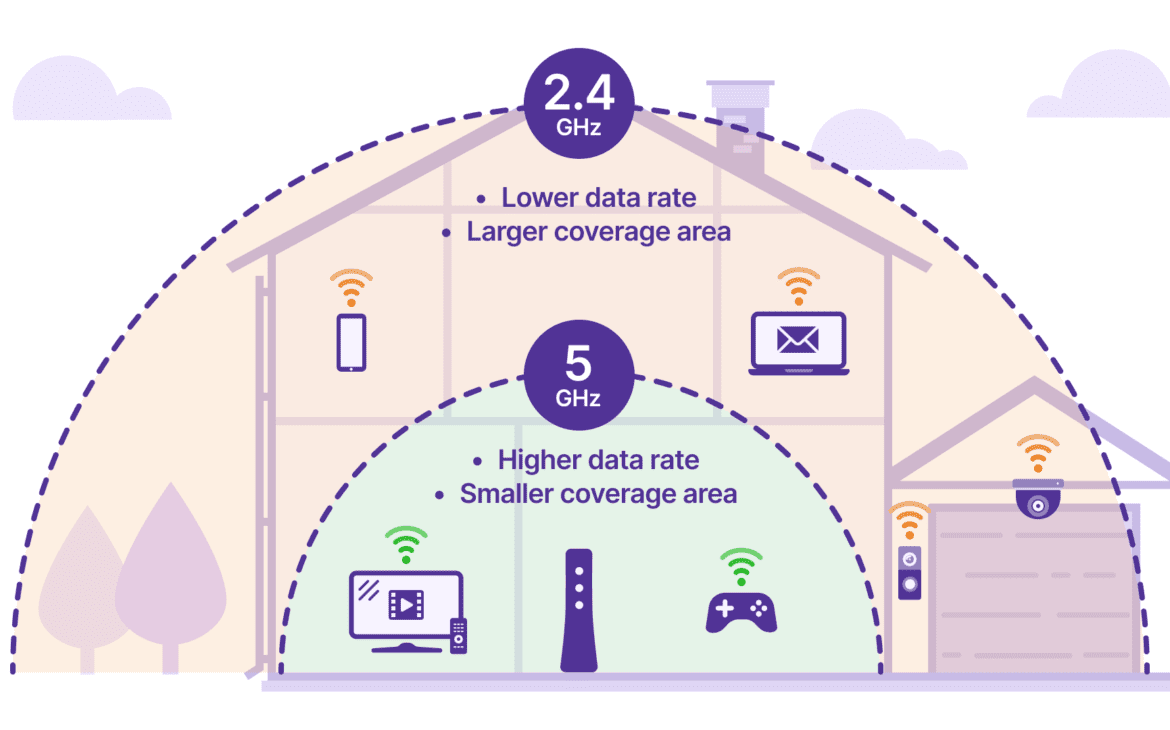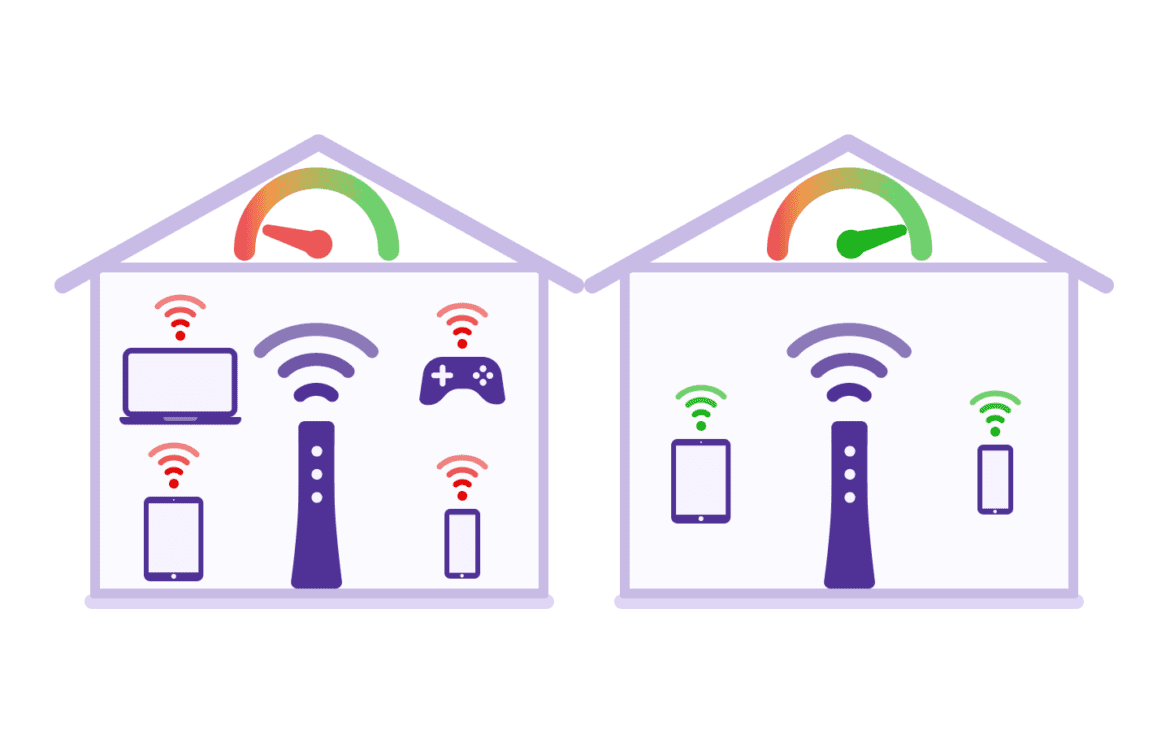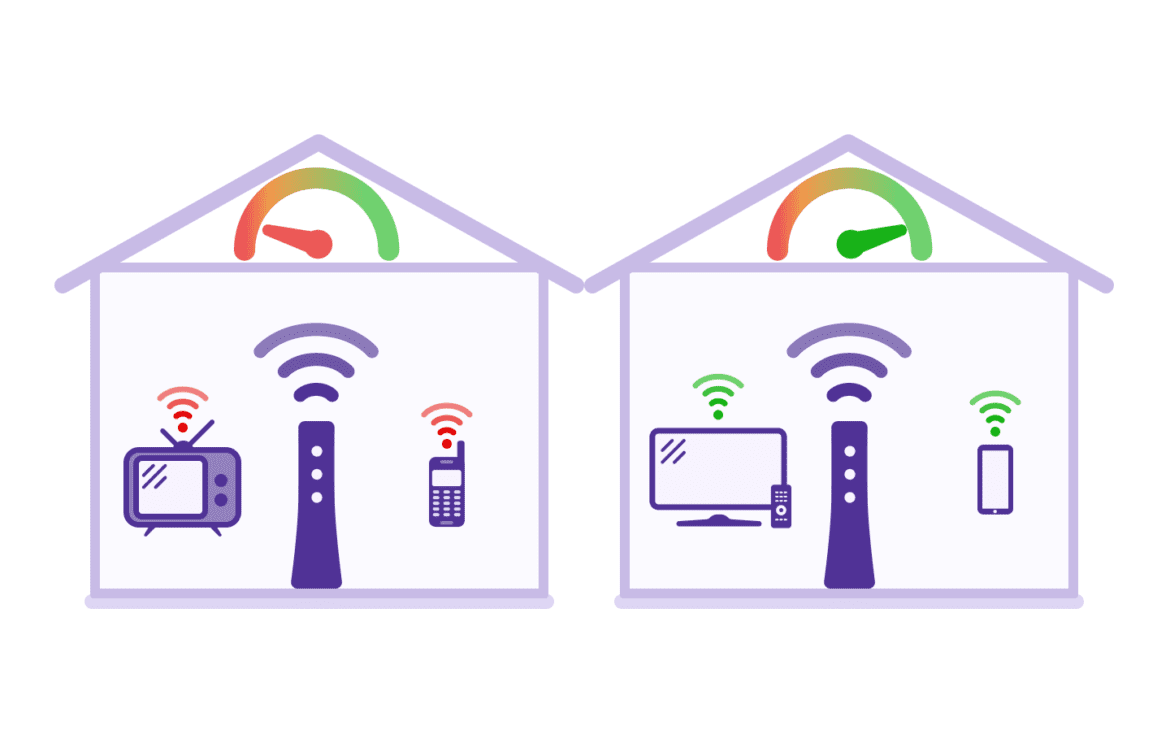Do you have a need for speed? If you’re into gaming, use a lot of IoT technology, or everyone in your household wants to stream a different show simultaneously, you might wonder if your internet speed is fast enough. Maybe you’re paying for 80 Mbps but only getting 60. So, what are good internet speeds?
Understanding internet speeds can be complex, but all you really care about is if you’re getting enough speed for what you need, right? Let’s run through what you need to know about the factors impacting your speed and bandwidth—so you can stream, game, browse, upload, and download to your heart’s content.
Internet speed vs. bandwidth: Aren’t they the same thing?
The terms “speed” and “bandwidth” often get used interchangeably, but they’re not the same. Speed refers to how fast data gets transferred, while bandwidth refers to how much data your internet connection can handle.
Imagine the internet network is a four-lane highway, and the cars traveling it are pieces of data. Bandwidth refers to the number of vehicles that can cruise along the highway without jam-ups or breakdowns. The wider the highway, the faster the cars can zip through. In short, the more bandwidth you have, the quicker the data can move through the network without interruption or lag.
Without getting too technical, both speed and bandwidth are measured in Megabits per second (Mbps). Suppose your internet plan has a bandwidth of up to 80 Mbps. That means the highest volume of data (or the maximum number of cars on the highway) is 80 Mbps. The more vehicles on the highway, the slower they can travel toward their destination.
If you have multiple users on your network using a bunch of devices, you need more bandwidth. But the type of service you have dictates how much bandwidth you can get. Fiber internet provides significantly more bandwidth than other services such as DSL, cable, or satellite and offers speeds of up to 940 Mbps. How fast is 940 Mbps? Fast—really fast, and that’s not nearly our top speed. In select areas Quantum Fiber offers multi-gig speed plans of up to 1 Gbps, up to 3 Gbps, and even up to 8 Gbps. That means speeds 15x faster than average advertised download speed in the U.S. for 3G and 40x faster for 8G! (Based on the weighted average advertised U.S. data connection download speed of participating Internet Service Providers of 193.9 Mbps. FCC Measuring Fixed Broadband Eleventh Report, December 2021.)
That’s because it uses fiber-optic cables that transmit data through light pulses that travel at an incredible rate of speed without any lag or lost connection. Think of it like this—if the highway you’re traveling on is made of fiber, you’re going to arrive at your destination on time (or ahead of schedule!) without any delays en route.
Upload speed vs. download speed
Take a look at your internet plan. Suppose it says you have 80/40 Mbps. That means you have a download speed of 80 Mbps and an upload speed of 40 Mbps. So, which is more important? If you do more than basic stuff online (which is most of us these days), you need them both.
Download speeds are usually what people focus on most when it comes to their internet speed. When you stream a movie or browse the web, you download content from other servers. Your internet connection then delivers that data to you. But if you’re also sending large files, videoconferencing, or trying to publish your latest vlog, you need upload speeds that can deliver your data to other servers or devices faster than you can say, “I need that file yesterday.”
Most internet plans offer asymmetrical download speeds. That means your download speed will typically be much faster than your upload speed. Thanks to advancements in internet technology (like fiber-optic networks and better hardware), you can enjoy symmetrical upload and download speeds, which deliver the same speeds. Suppose you have fiber internet with 1 Gbps. In that case, your fiber upload speed is as fast as your download speed, so that information can move to and from your devices at the same incredible speed. The same goes for Quantum Fiber’s multi-gig speeds of up to 3 Gbps and up to 8 Gbps!

Life in the slow lane: Poor internet speeds explained
Let’s say you did purchase an internet service plan for 80 Mbps, but you aren’t seeing internet speeds that fast on your devices. You could be getting those slower speeds for a variety of reasons. Maybe you’re too far away from the router that’s distributing your WiFi signal. The type of internet you have could have an impact too. Or it could be related to the age of the wiring inside your home or building. Here are a few other factors to consider:
You have loads of devices connected
Every device you connect to the internet sends and receives data—and they’re all using some of your precious bandwidth. The more devices you connect, the less available bandwidth and the slower your internet speed. You can either unplug some or boost your connection with fiber.
Your devices may be outdated
Your old smartphone might have been the fastest in its prime, just like that classic ’68 Dodge Charger. But now, it could be slowing down your entire network. Did you know that every device you own, from IoT devices to gaming consoles to that sweet 4K smart TV, has its own speed limits? These devices are like lanes on your bandwidth highway. Some of these roads have slower speed limits, while others let you put the pedal down.
Older devices, like that slow travel lane, can only handle so much data. Newer devices, like the high-speed lane, have faster processing times and more antennas to receive WiFi signals, so you can sail along at Grand Prix speeds.
The type of device you’re using also matters. A laptop generally has more wireless antennas than a smartphone, so your computer can transfer data faster than your phone.
Your residential gateway is outdated
Like all your devices, routers and modems lose their superpowers as they get older and better technology emerges. Besides slowing down or disrupting your service, an outdated router can also affect your network’s security. If your router or modem is over three years old, it’s time to upgrade.
You’re not using a wired connection
When was the last time you connected to the internet via Ethernet? It’s probably been a while. With routers built into many modems, getting online pretty much equates to using WiFi.
But when the signal gets broadcast wirelessly, your connection loses steam. A wired connection will give you the best online experience. Remember that the next time you’re streaming that blockbuster action flick in super-HD or going head-to-head in a FIFA or Madden competition.
You’re on the wrong WiFi frequency
Some WiFi signals use the same frequency (2.4 GHz) as microwaves, cordless phones, baby monitors, and garage door openers. Since your WiFi must compete for that frequency with these other devices, moving to a different frequency (5 GHz) can help improve internet speeds.
On the flip side, using the 5 GHz frequency far away from your router may affect your speeds. That’s because 5 GHz doesn’t do well with physical obstructions, like walls. When you use the 5 GHz frequency, it’s best to be as close to your router as possible.
Your residential gateway may already support automatic band-switching. That means it can detect and switch your device to a better frequency. But you can always go in and manually adjust if you need to.
Learn more about WiFi and how it works.

You’re stuck in traffic
Going back to our highway scenario, just as rush hour traffic causes slowdowns, using the internet during peak hours can create a sluggish experience. Many websites or apps experience significant traffic, putting extra stress and demand on their servers.
And if your content has to go through a third party or a network with data caps or bandwidth limitations, you’ll likely get slower speeds. Imagine you’re exiting a highway. Roads, roundabouts, and other infrastructure of various sizes and frameworks impact the maximum speed you can go within the vast transportation network (the World Wide Web).
Your provider isn’t delivering the full goods
Internet speeds from your ISP are usually pretty consistent. Outages and slowdowns occur from time to time, but when speeds fluctuate, it often has to do with what’s happening on your end of the residential gateway. Your service provider may claim to be delivering 80 Mbps when they’re actually delivering less.
Your provider has data caps
Suppose you’ve reached the maximum amount of data your internet plan allows. In that case, your ISP may implement data caps on your service, which can seriously slow down your internet speeds. If you’re simply browsing, you won’t be affected too much. But activities that use a lot of bandwidth, like streaming and gaming, can be significantly impacted. If you have fiber speed, you won’t have any data caps, so you can stream or game as long as you want.

So, is your internet speed good or not?
When you think about your internet experience, it really comes down to one thing—speed. Let’s face it. We want internet that works and works fast. To better understand what speeds are adequate and what speeds are fast, let’s look at general household broadband guidelines from the FCC.
Basic Service = 3 to 8 Mbps
This speed can sustain one to two individual devices for light internet use and activities like checking email, browsing, or watching videos. Basic service can also support one device for more moderate use, like streaming HD video, videoconferencing, or online gaming.
Medium Service = 12 to 25 Mbps
Speed in this range can support three to four devices doing light internet activities, up to three devices for moderate activities, or one to two devices performing more advanced functions, like running high-demand applications simultaneously.
Advanced Service = More than 25 Mbps
Speeds higher than 25 Mbps can support four devices across basic, moderate, and advanced internet activities. But keep in mind that these guidelines only factor in one device per person. If your household has multiple users juggling a bunch of devices, you’ll need more Mbps for optimal performance. And let’s face it—you probably do. The average American household uses 11 connected devices. The more connected devices you have, the more bandwidth you need.
That’s why you should consider fiber internet. With Quantum Fiber this amazing technology gives you speeds up to 8 Gbps (in select areas.) That’s 40 times faster than the average U.S. download speed. (Based on the weighted average advertised U.S. data connection download speed of participating Internet Service Providers of 193.9 Mbps. FCC Measuring Fixed Broadband Eleventh Report, December 2021.) To put that into perspective, suppose you’re downloading an ultra-HD 4K movie. With traditional internet, it could take around 2 hours. But with fiber internet speeds, we’re talking under three minutes! Are you an avid gamer? With fiber internet speeds, you can download Call of Duty: Warzone 2 in about 16 minutes.
Another noteworthy benefit of fiber internet is that you can upload as quickly as you can download. The fiber difference is priceless if you regularly send large files, participate in video conferences, or have a household filled with multiple users and smart home devices. It all comes down to bandwidth—fiber gives you more than enough.
The metaverse is coming, and it’s going to need loads of speed and bandwidth. That’s why we built Quantum Fiber.
The future of speed—Gigabit internet
We want to stream, game, download, upload, and browse—and we want it fast. That’s where gigspeed comes into play. Gigabit internet gives you speeds of 1 Gbps—equal to 1,000 Mbps. How does that compare to other internet services? Considering that DSL speed averages 10 Mbps or less and the typical cable speed is around 25 Mbps, there’s simply no comparison. We’re talking Superman-circling-the-planet fast, and Quantum Fiber speeds reach as high as 3 and 8 Gbps in select areas.
Fiber internet gives you incredible download and upload speeds, the bandwidth to handle loads of users and devices, the stability and durability to withstand whatever Mother Nature throws at you, and a safe, secure connection for all your sensitive data.
Upgrade to tomorrow’s speed today.
How to make your internet speed faster
- Think about how to manage internet speed when you need it most at home. If you have dust-covered equipment using up valuable bandwidth, turn it off or disconnect it to give the devices you actually use more capacity. If multiple users vying for bandwidth in your household are at odds, it’s time to take off the gloves. Set up a schedule that accommodates everyone by alternating when users participate in high-consumption activities like streaming videos or teleconferencing.
- Take advantage of off-peak hours when traffic demand is at its lowest.
- Upgrade your current internet service. See what options are available in your area.
Want to know how to eliminate lag and lost connections? Try these tips.
Content Disclaimer – All content is for informational purposes only, may require user’s additional research, and is provided “as is” without any warranty, condition of any kind (express or implied), or guarantee of outcome or results. Use of this content is at user’s own risk. All third-party company and product or service names referenced in this article are for identification purposes only and do not imply endorsement or affiliation with Quantum Fiber. If Quantum Fiber products and offerings are referenced in the content, they are accurate as of the date of issue. Quantum Fiber services are not available everywhere. Quantum Fiber service usually means 100% fiber-optic network to your location but, in limited circumstances, Quantum Fiber may need to deploy alternative technologies coupled with a non-fiber connection from a certain point (usually the curb) to your location in order to provide the advertised download speeds. ©2025 Q Fiber, LLC. All Rights Reserved. Quantum, Quantum Fiber and Quantum Fiber Internet are trademarks of Quantum Wireless LLC and used under license to Q Fiber, LLC.










